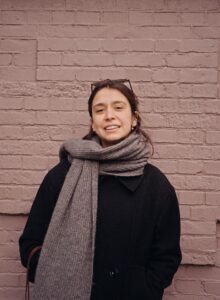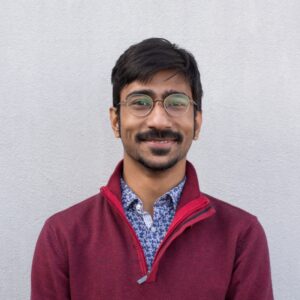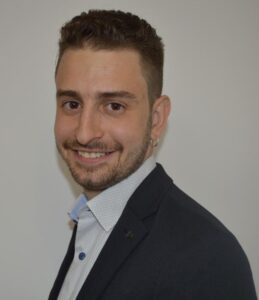ESB Mobility Award Winners – 2022
Zeynep Karagöz

Zeynep Karagöz is a PhD student at the MERLN Institute for Technology-Inspired Regenerative Medicine in Maastricht Universrity since September 2019. She earned her bachelor’s degree in molecular biology and genetics at Bogazici University in Istanbul in 2016. Same year, she moved to Munich, Germany to start her master’s studies at Ludwig-Maximilian University (LMU) where her focus was computational biology and bioinformatics. She gained experience in several RNA sequencing and statistical data analysis methods as well as transcriptome assembly methods. For her PhD, she is now working on computational modeling of cell – extracellular matrix (ECM) interactions to understand how cell decision making is affected by changes in the ECM. Her main focus is at multiscale modeling the mechanosensitive initiation of reversible fibroblast to myofibroblast transition, a process which is important for wound healing.
Planned Research Project
“Coupling agent-based and finite element models to understand the mechanism of action in reversible, tension-dependent fibroblast to myofibroblast transition”
Thanks to the ESB Mobility Award, Zeynep will travel to the Julius Wolff Institute in Berlin for 3 months, working with Prof. Sara Checa, in the Computational Mechanobiology research group.
Successful wound healing depends on the mechanically driven, reversible fibroblast to myofibroblast transition (FMT). Failure to inactivate myofibroblasts after wound closure may result in fibrosis or scar formation due to exaggerated deposition of extracellular matrix (ECM). A better and more complete understanding of reversible FMT is necessary to improve fibrosis prevention and regenerative medicine approaches. With this project, the aim is to address this knowledge gap and to unravel the mechanism of action behind the mechanically driven, reversible FMT via the generation of a novel, multiscale computational model of the FMT process. The multi-scale model will comprise two parts, namely the agent-based model (ABM) of the cellular level processes and the tissue level finite element model (FEM) of ECM mechanics. FEM and ABM will be iteratively updated to mimic the tissue growth and ECM production and remodeling during the FMT process. Using the successfully implemented multi-scale model, predictions will be made on optimal ECM conditions for improved wound healing and fibrosis prevention.
Satanik Mukherjee

Satanik Mukherjee is a PhD student since 2018 in the division of Biomechanics at the Department of Mechanical Engineering in KU Leuven, Belgium. Prior to his starting his PhD, he studied Bachelor of Mechanical Engineering in Jadavpur University, India and obtained his Masters in Applied Mechanics from the prestigious Indian Institute of Technology, Delhi. His PhD thesis is focused on developing multiscale computational models of the knee joint and other bioreactor setups typically used in skeletal tissue engineering. These multi-scale models would help in identifying mechanical and biochemical stimulus which will aid tissue engineers in generating cartilage as well as to devise physio-therapeutic strategies to arrest Osteoarthritis.
Planned Research Project
During the proposed research stay of two months facilitated by the ESB Mobility Award 2022, Satanik intends to work closely with the group of Prof. Nico Verdonschot in University of Twente, to use a musculoskeletal model developed in his lab to infer about the knee joint kinetics and kinematics for a range of motions both for healthy patients and patients with OA and total knee arthroplasty (TKA). Furthermore, a cartilage on chip system developed in collaboration with Prof. Marcel Karperien in University of Twente will be used to generate relevant experimental data to validate the multiscale model developed by the candidate. This setup is very efficient in not only mimicking the complex multi-axial loading scenario that is experienced in vivo (in the knee joint), but also can be used to test the effect of inflammatory cytokines (such as IL-1 and TNF-α ) on the fate of articular chondrocytes, in combination with mechanical loading. Therefore, this microfluidic setup is a perfect choice to validate the multiscale model that has been developed by the candidate, which is a second objective of the research stay.
Iulen Cabeza-Gil

Iulen Cabeza-Gil continues as postdoctoral researcher at the University of Zaragoza, Spain, after defending his PhD thesis entitled “A numerical exploration of the crystalline lens: from presbyopia to cataracts and intraocular lenses” in June 2022. His main research is focused in developing ophthalmic solutions related to presbyopia and cataracts. During his PhD, he performed several numerical studies using the finite element method. Additionally, he has recently expanded his research towards in vivo human studies with subjects with his secondment at the Bascom Palmer Eye Institute, where he has enhanced his vision science skills for quantitative image processing. His motivation is to develop an accommodative IOL that behaves like a healthy lens.
Planned Research Project
To characterize the mechanical properties of the crystalline lens using optical coherence elastography and inverse finite element analysis
Thanks to the ESB Mobility Award for Young Researchers Iulen will travel to the University of Bern, Switzerland, where he will work under the supervision of Sabine Kling for three months. The goal of his research stay is to characterize the lens mechanical properties investigating if the lens nucleus is softer than the lens cortex in young subjects. The results will shed light on mechanism of accommodation.







